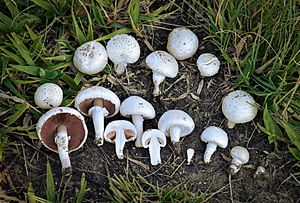Agaricus facts for kids
Quick facts for kids Agaricus |
|
|---|---|
 |
|
| Agaricus campestris | |
| Scientific classification |
|
| Kingdom: | Fungi |
| Division: | Basidiomycota |
| Class: | Agaricomycetes |
| Order: | Agaricales |
| Family: | Agaricaceae |
| Genus: | Agaricus L.:Fr. emend Karst. |
| Type species | |
| Agaricus campestris L.:Fr.
|
|
| Synonyms | |
Agaricus is a group, or genus, of mushrooms. It includes many different types, with over 300 kinds found all over the world. Some Agaricus mushrooms are safe to eat, like the common "button" mushroom (Agaricus bisporus) and the field mushroom (A. campestris). These are the most popular mushrooms grown and eaten in many Western countries. However, some Agaricus species can be poisonous, so it's important to know which ones are safe.
Agaricus mushrooms have a soft, fleshy cap, called a pileus. Underneath the cap, they have many thin plates called gills. These gills produce tiny spores, which are like seeds for mushrooms. A special feature of Agaricus mushrooms is their chocolate-brown spores. They also have a stem, or stipe, that lifts the mushroom above the ground or whatever it's growing on. A part called a partial veil protects the young gills. As the mushroom grows, this veil breaks and forms a ring, or annulus, around the stem.
Contents
Naming and Classifying Agaricus Mushrooms
For a long time, many mushrooms in the Agaricus group were called Psalliota. You might still see this name in older mushroom books. The name Agaricus likely comes from an ancient area near the Sea of Azov, where a group of people called the Agari lived.
Scientists use a system to name and group living things. This helps them understand how different species are related. For Agaricus, scientists have studied its history and how its name has changed over time. The famous scientist Carl Linnaeus first named the genus, but the name was later officially set by Elias Magnus Fries in 1821.
The alternate name, Psalliota, comes from an Ancient Greek word meaning "ring." This makes sense because many Agaricus mushrooms have a ring on their stem.
How Agaricus Mushrooms are Related
Scientists use special methods, like studying DNA, to figure out how different Agaricus species are related to each other. This helps them understand the family tree of these mushrooms. Before DNA analysis, scientists grouped Agaricus mushrooms into different sections based on how they looked and how they reacted to certain chemicals.
Main Groups of Agaricus
The Agaricus genus is divided into several main groups, or sections. These groups help scientists organize the many different species. Here are a few examples:
- Section Agaricus
- Section Arvense: This group includes species similar to the horse mushroom (A. arvensis).
- Section Xanthodermatei: This group includes species that are similar to the yellow stainer mushroom (A. xanthodermus).
- Section Duploannulatae: This group includes well-known species like the common button mushroom (A. bisporus) and the pavement mushroom (A. bitorquis).
What Agaricus Mushrooms Can Be Found?
The Agaricus genus has about 200 different species around the world. Some are very common, while others are rare.
Here are a few well-known Agaricus species:
- Agaricus bisporus – This is the common button mushroom you see in stores.
- Agaricus campestris – Also known as the field mushroom, often found in grassy areas.
- Agaricus arvensis – The horse mushroom, which is edible.
- Agaricus augustus – Known as "the prince," a large and tasty mushroom.
- Agaricus bitorquis – The pavement mushroom, known for growing in hard ground.
- Agaricus deserticola – A mushroom found in desert areas.
- Agaricus silvaticus – The scaly wood mushroom.
- Agaricus subrufescens – Also called the almond mushroom or mushroom of the sun.
- Agaricus xanthodermus – The yellow-staining mushroom, which is poisonous.
Are Agaricus Mushrooms Edible or Poisonous?
The Agaricus genus includes the most popular and well-known edible mushrooms today. The common button mushroom (A. bisporus) and the field mushroom (A. campestris) are widely eaten. Some other species, like A. porphyrocephalus, are also considered very good to eat.
However, it's very important to be careful! Not all Agaricus mushrooms are safe. The yellow-staining mushroom (A. xanthodermus) is a notable species that is not safe to eat. It can cause upset stomachs. One species found in Africa, A. aurantioviolaceus, is even reported to be deadly poisonous. Always be sure of a mushroom's identity before eating it!
Images for kids
-
Common button mushroom, Agaricus bisporus
See also
 In Spanish: Agaricus para niños
In Spanish: Agaricus para niños














